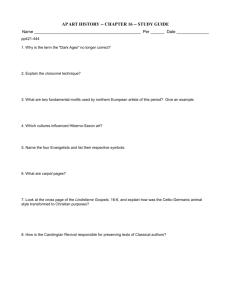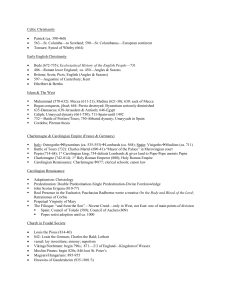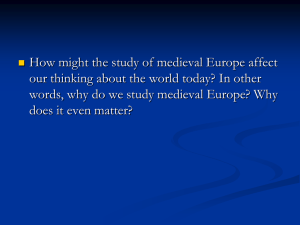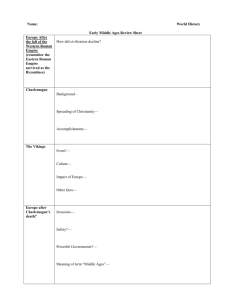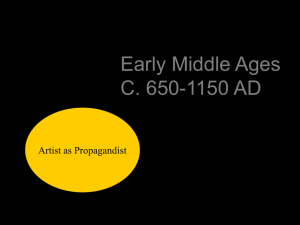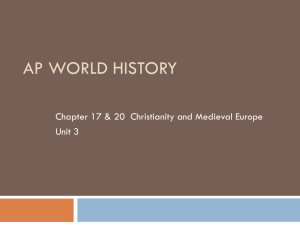Crucifixion with Angels and Mourners Lindau Gospels 870
advertisement
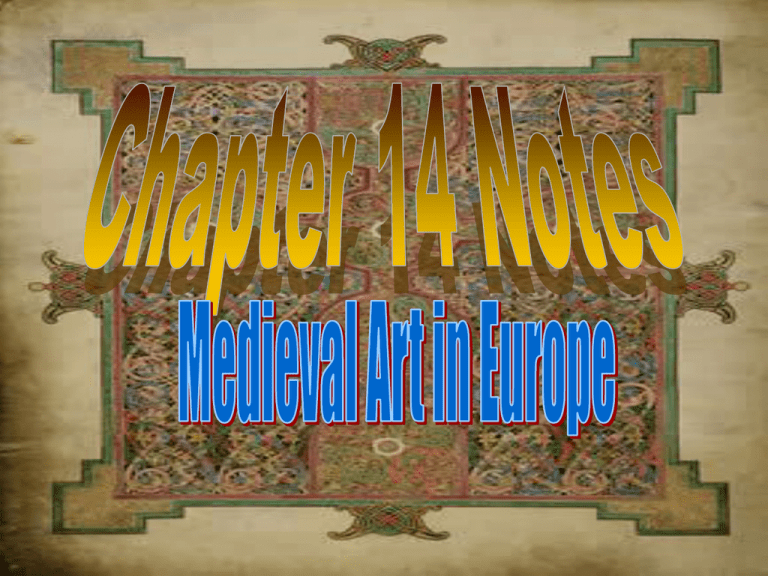
Objectives…WOOT!!! • Gain an understanding of the basic geography of Western Europe and be able to see ancient territories beneath the labels of modern states. • Understand the vastness of the vacuum due to the departure of Rome. • Grasp the unique characteristics of developments in the British Isles. • Appreciate the enormous consequence of Charlemagne's decision to resurrect the "Roman Empire." • Estimate how Charlemagne's new empire looked backwards toward Rome as well as surveyed the new values and attitudes attendant in the triumph of Christianity in Western Europe. Groups to Know • Barbarians: Those outside of the Roman Empire • Visigoths: Spain • Celts: Ireland/Scotland • Anglo-Saxons: Britain • Franks: Germany • Huns: Central Asia • Norse: Scandinavia The Early Middle Ages • Decline of the Roman Empire in the 4th-5th centuries • Authority replaced by Barbarians • Celts controlled most of Europe • Goths lived around the Baltic Sea • Saw the better standard of living in the Roman Empire • Moved in • Beginning of feudalism The Visigoths • Lived outside the Roman Empire • Moved in across southern France and settled in Spain • Adopted Latin and accepted Roman Christianity • Superior metalworkers • Eagle Brooch • 6TH Century • Spain • Gilt, Bronze, Crystal, Garnets The Celts and Anglo-Saxons • Angles and Saxons from Germany – Occupied Britain • Hiberno-Saxon – Hibernia = Roman name for Ireland • Burial Ship at Sutton Hoo – 90 ft. long – Designed for rowing – Weapons, armor, and other equipment to provide for a ruler’s after life Purse Cover from Sutton Hoo Burial Ship • 7th Century • England • Artist used cloisonne technique – Cells formed from gold wire to hold pieces of garnet or glass Christianity • Monasteries flourished in the Celtic world • Illustrated books among the best surviving artwork of the time • Used for missionary activities throughout the early Middle Ages • Spread the news of Christianity • Glorified the Word of God Book of Kells • One of the most beautiful Hiberno-Saxon Gospel books – Spiral Interlace • Chi-Rho Iota is most celebrated page – Greek Letter XPI • Introduces Matthew, beginning the account of Jesus’ birth • Each letter is outlined • Painter inserted numerous pictorial and symbolic references to Christ – – – – – – Initials Fish Moths Cross-Inscribed Eucharist wafer Chalice Angels Carolingian Empire • Charles the Great, or Charlemagne, is King of the Franks • Crowned Holy Roman Emperor by Pope • Revives a strong, efficient government • Stimulates renewed interest in learning and art (esp. from ancient Rome) Carolingian Renaissance • New capital at Aachen Carolingian Architecture • Inspired by Roman and Early Christian architecture • Charlemagne’s palace complex at Aachen provides an example of this synthesis • Palace Complex – Charlemagne’s private chapel – Imperial mausoleum – Central-Plan with an octagonal twist Palace Chapel of Charlemagne 792-805 Aachen Lindau Gospels • Manuscript covers were often made of valuable materials • Lindau gospels made at one of the monastic workshops • Crucifixion = Common theme • Gold figures formed using the repousse method • Angels hover over Jesus’ head Crucifixion with Angels and Mourners Lindau Gospels 870-80 Gold, Pearls, Sapphires, Garnets, and Emeralds Gero Crucifix • Archbishop Gero of Cologne commissioned the sculpture • 6 ft. tall Gero Crucifix 970 Germany Oak Christ Washing the Feet of His Disciples • • • • • Peter protested Elongated limbs Figure unbinding his sandals Figure holding a basin of water Apostles look on with wide eyes…REALLY wide eyes Christ Washing the Feet of his Disciples 1000 Vellum
